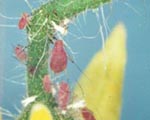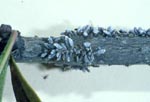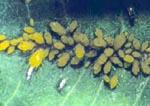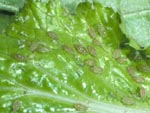
|

Aphids
Aphis spp.
|
Description
Aphids may be green, black, brown, red, pink, or some other
color depending on the sap color of the host plant. They are
usually slow-moving insects with somewhat pear-shaped bodies
ranging from 1 /16 to 1 /8 inch long. There may be various
sizes of wingless aphids (nymphs and adults) in a dense colony
on a stem, on the underside of the foliage, or on the flowers.
Later in the season, some may have relatively large, transparent
wings. The slender antennae are conspicuous, and near the
rear end of the abdomen there are two tubes called cornicles.
|
Click
on image for larger version

Figure 1. Aphids on Tomato Plant |
Click
on image for larger version

Figure 2. Aphids on Pittosporum |
Life
History
The life history of aphids is somewhat complicated and varies
with the species. One of the less complicated life histories
proceeds as follows: Overwintering eggs on branches and stems
hatch in the spring to produce a wingless form known as the
stem mother. The unfertilized stem mother gives birth to living
young in great numbers. Several generations may occur in this
fashion, but in due time some individuals will develop wings
(alates) and migrate to another host. Here they may deposit
eggs for the winter or, after a few generations, migrate back
to the original host to lay eggs. |
Damage
Aphids are sucking insects that feed by thrusting a long beak
into the plant tissue. They withdraw great quantities of sap,
some of which they execrete as "honeydew". The honeydew
makes the plant sticky. When trees are heavily infested with
aphids, sidewalks, lawn furniture, and automobiles may become
wet with honeydew. A sooty mold often develops with the honeydew
blackening stems and foliage. This fungus is not parasitic to
the plant, but reduces the amount of photosynthetic area. Leaves
of plants may be distorted by aphids feeding on the undersides.
Succulent stems may wilt or growth may be arrested by colonies
of aphids. On the other hand, damage caused by aphids feeding
on the bark of trees or woody shrubs cannot be readily seen. |
Click
on image for larger version

Figure 3. Aphids on Milkweed |
Click
on image for larger version

Figure 4. Green Peach Aphids on Mustard Leaf |
Nonchemical
Control
Plants that are well established and vigorously growing usually
can tolerate low to medium aphid population levels. Newly transplanted
trees or stressed plants are more vulnerable to aphid damage
and control should be considered. Aphid populations are usually
controlled later in the season by natural enemies such as parasites,
predators, and pathogens. In some cases, populations may crash
literally overnite due to weather conditions. |
Chemical
Control
Apply an insecticide when aphids are numerous. Spray with high
pressure and throroughly cover the foliage |
Click
on image for larger version

Figure 5. Aphids on Spirea |
|
|

|

|



